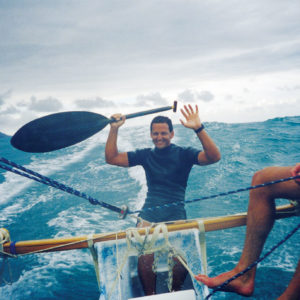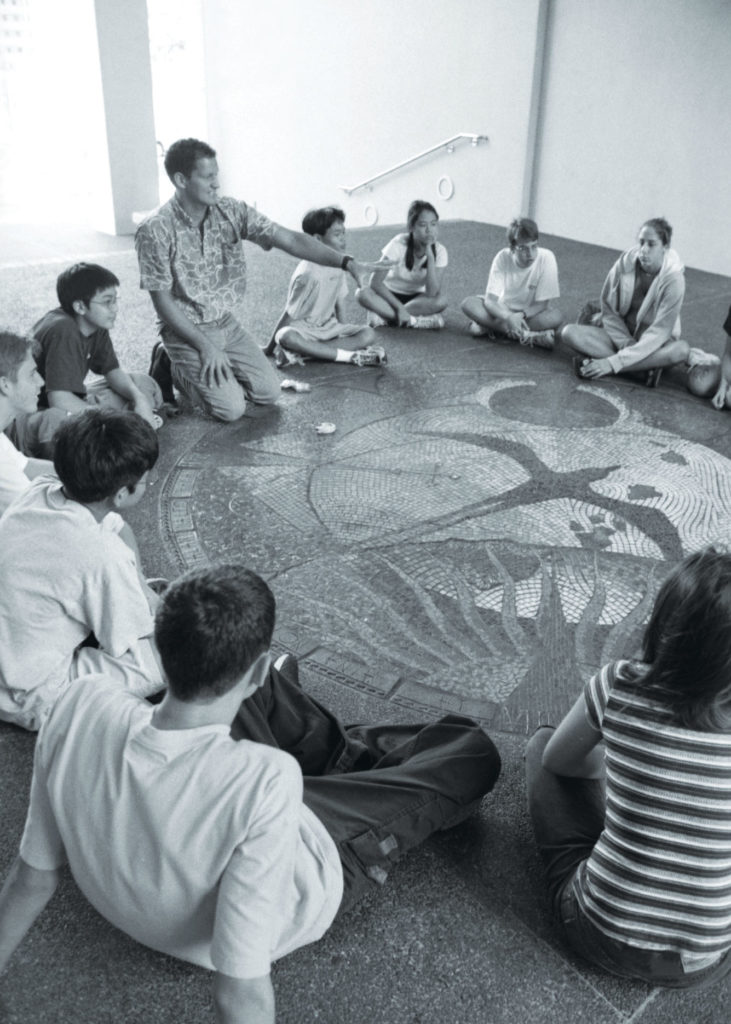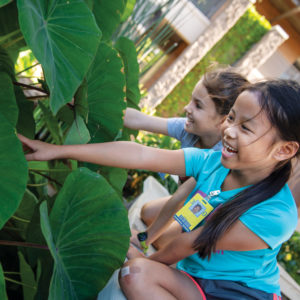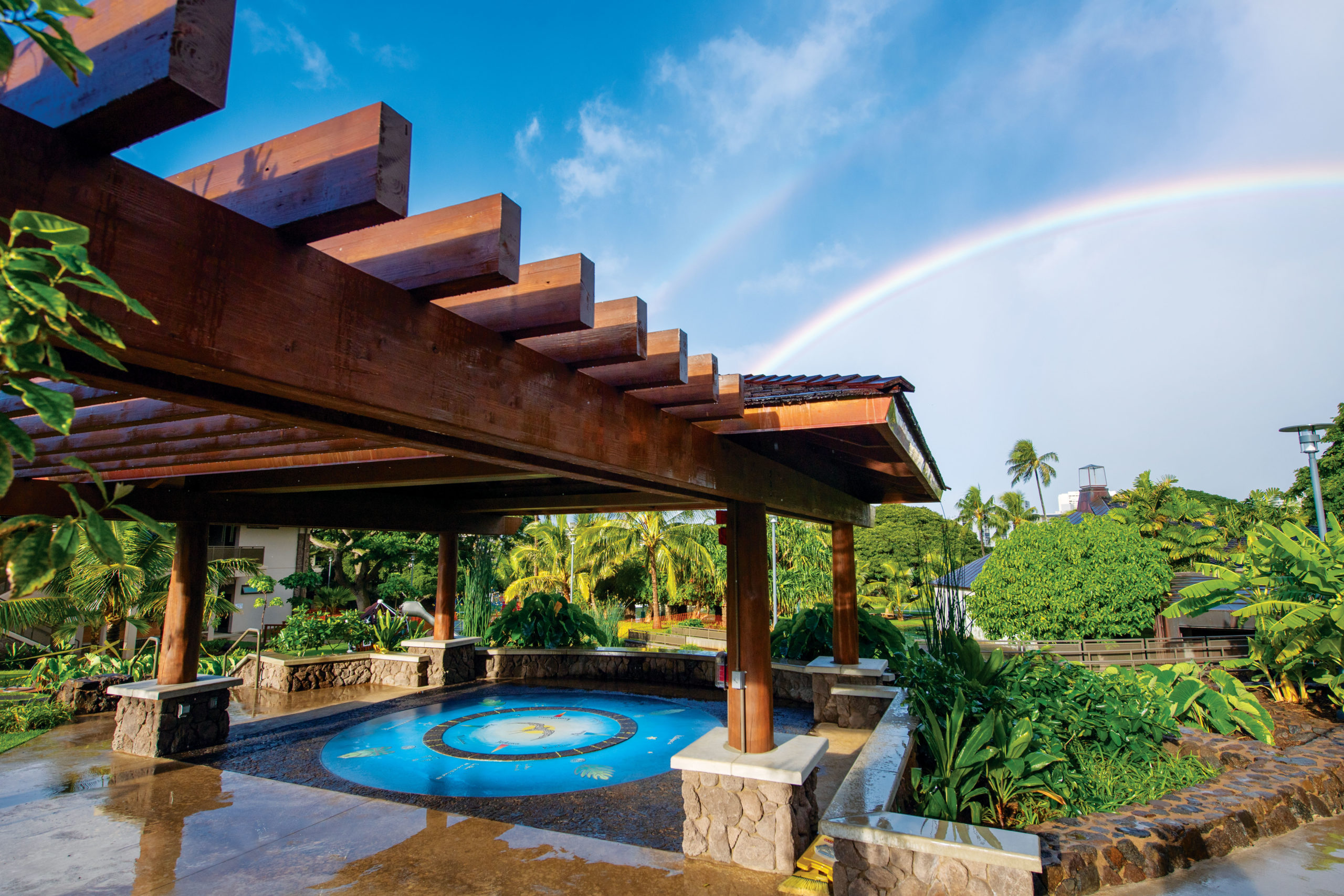Ka‘aumoana, standing beside Ka Punahou – the spiritual, geographic and historic heart of campus – is a magical place where children play, sing, enjoy the outdoors, discover Hawaiian culture and learn to love and care for their Island home. It’s where they hear Hawaiian stories and imagine our Islands’ voyagers navigating across vast oceans.
The open-sided hale, with water from Ka Punahou nourishing its lo‘i kalo, was gifted to Punahou by Luanna Farden ’56 and Peter McKenney to honor their late son, David Ka‘aumoana McKenney ’83 (Ka‘au), who was a beloved, seventh-grade social studies teacher at Punahou.

Sturdy ‘ohi‘a posts from Hawai‘i Island, a lava rock floor and moss rock walls complete this Hawaiian place for outdoor education. “Our vision for the hale is that it would serve multiple functions – a learning space for students and teachers; a gathering place for mele, hula and storytelling; and also a special spot on campus for personal reflection and contemplation,” says former Punahou President Jim Scott ’70, who conceptualized Ka‘aumoana as Sidney and Minnie Kosasa Community for Grades 2 – 5 was being planned. “All of these represent strongly held values for the McKenney family, and provide an inspiring memory of Ka‘au as a teacher, colleague, friend and son.”
Scott says Ka‘aumoana was created as a metaphor for continuous renewal, restoration and replenishment for a community of lifelong learners. Fresh springs from Ka Punahou now flow through Ka‘aumoana, offering its life-giving force. “The wai was the source of life for Hawaiians, and it was in the water where Ka‘au felt most at home,” Scott says.

Photo: Punahou Archives, 2000
Ka‘au indeed gravitated to the ocean as a young boy, and his love for the water and nature remained throughout his life. An avid wind and kite surfer, paddler and diver, he was the consummate waterman and outdoorsman. He became a protégé of Nainoa Thompson ’72 and Micronesian navigator Mau Piailug, who taught him the art of traditional Polynesian wayfinding. In 1995, he navigated to Tahiti, and later, sailed on a number of Hokule‘a voyages. He was part of the next generation that Thompson and the early leaders of the Polynesian Voyaging Society were grooming to revive traditional navigational arts and to spread the values and vision of Hawaiian culture worldwide.
“In front of all of our eyes, Ka‘au excelled,” Thompson said. “It was the way he behaved in the sea, in nature, on that canoe and his core values that I believe came from family; he treated everybody with compassion and caring.”
Puakea Nogelmeier, a professor emeritus at the University of Hawai‘i, Manoa and a Hawaiian language and culture resource, says Ka‘aumoana refers to an ocean voyager, not on a pleasure sail, but one embarked on a purposeful journey to reach a planned destination. “It’s a wonderful metaphor for understanding the skills and lessons that we all can learn in this outdoor education center,” he says.
A Compass for the Children
Ka‘au’s deep connection to wayfinding and voyaging is reflected at Ka‘aumoana with a stunning Polynesian Star Navigational Compass, designed by artist Leighton Lam ’74. Constructed in bronze and concrete, it is an impressive work of art, surrounded by lava rock.
While the compass honors Ka‘au’s knowledge as a navigator, it also introduces children to the skills and mindset of a voyager. Wayfinding teaches children about taking risks, discovering themselves, being attentive to symbols and signs, and respecting their elders and mentors, Scott says. “It teaches all the 21st century learning skills – collaboration, communication, creativity, critical thinking and compassion. These are the qualities we want in our children, but these are also the qualities that you would want with your fellow seamen in a canoe.”

Now at Ka‘aumoana, children can continue to learn these values.

“This gift – it’s so valuable, important and so core to who Ka‘au was, defined by his values, by what he believed in, what he stood for and how he would act on it,” Thompson said. “It’s a memory of his deep love for nature and his deep, very, spiritual connection to the oceans. When you create a space for young children to connect to nature, to understand the language, I don’t think we really realize how important that is.”
Children also will learn Thompson’s message to malama honua or care for the earth.
In Ka‘au’s honor, Thompson named a star after him, called Ka‘aumoana. Lam placed Ka‘au’s star in the compass, just to the right of Hoku Pa‘a, the steady North Star. Lam also included in the center of the design a beautiful white bird, the Manu O Ku, which shows Polynesian voyagers the way toward land.
When Lam showed the McKenneys his early sketch of the Manu O Ku, they immediately recognized the spirit of their son. “They knew this was going to be something that would speak to who they were, who Ka‘au was, and what Punahou is,” says Lam, who used to surf and windsurf with Ka‘au. “I wanted to make a compass that honors those who explore and pass on knowledge of the ocean, earth and universe as Ka‘au did in his life as a Punahou School teacher and through his love of the ocean. I want kids to come here and feel like they are stepping from the lava rocks into the ocean and gaze into the sky, to see the past, be present now and inspired for their future. Hopefully, this will inspire many generations to explore and find ways to navigate the world and life.”

With the construction complete and the water from Ka Punahou flowing, the McKenneys are filled with gratitude for those who made it possible. “It’s such a privilege to be able to give this gift, and to know that the mana that comes from the hearts of the Hawaiian people will go forward into the world through all the children of Punahou,” Luanna said.
Now, Peter and Luanna dream of what more Ka‘aumoana can offer to the Kosasa Community. Every morning, the Community welcomes children as they arrive. They stop to play in the ‘auwai (swales) and run past Hawaiian plants. A nearby imu is ready for the third-grade luau. Children’s voices fill the air with mele.
“We’re so pleased that the hale can be shared with children, and will inspire them to live aloha for one another, while commemorating our dear son who loved his students and was so proud to be a dedicated teacher at Punahou,” Luanna says.

